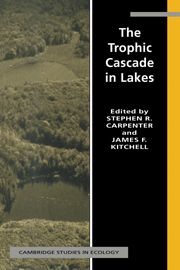Book contents
- Frontmatter
- Contents
- Contributors
- Preface
- 1 Cascading trophic interactions
- 2 Experimental lakes, manipulations and measurements
- 3 Statistical analysis of the ecosystem experiments
- 4 The fish populations
- 5 Fish behavioral and community responses to manipulation
- 6 Roles of fish predation: piscivory and planktivory
- 7 Dynamics of the phantom midge: implications for zooplankton
- 8 Zooplankton community dynamics
- 9 Effects of predators and food supply on diel vertical migration of Daphnia
- 10 Zooplankton biomass and body size
- 11 Phytoplankton community dynamics
- 12 Metalimnetic phytoplankton dynamics
- 13 Primary production and its interactions with nutrients and light transmission
- 14 Heterotrophic microbial processes
- 15 Annual fossil records of food-web manipulation
- 16 Simulation models of the trophic cascade: predictions and evaluations
- 17 Synthesis and new directions
- References
- Index
15 - Annual fossil records of food-web manipulation
Published online by Cambridge University Press: 06 August 2010
- Frontmatter
- Contents
- Contributors
- Preface
- 1 Cascading trophic interactions
- 2 Experimental lakes, manipulations and measurements
- 3 Statistical analysis of the ecosystem experiments
- 4 The fish populations
- 5 Fish behavioral and community responses to manipulation
- 6 Roles of fish predation: piscivory and planktivory
- 7 Dynamics of the phantom midge: implications for zooplankton
- 8 Zooplankton community dynamics
- 9 Effects of predators and food supply on diel vertical migration of Daphnia
- 10 Zooplankton biomass and body size
- 11 Phytoplankton community dynamics
- 12 Metalimnetic phytoplankton dynamics
- 13 Primary production and its interactions with nutrients and light transmission
- 14 Heterotrophic microbial processes
- 15 Annual fossil records of food-web manipulation
- 16 Simulation models of the trophic cascade: predictions and evaluations
- 17 Synthesis and new directions
- References
- Index
Summary
Introduction
Limnologists are interested in why lakes vary from year to year. Studies of temporal variability under baseline conditions are needed to quantify the relative importance of mechanisms regulating production, to interpret ecosystem experiments and to help solve lake management problems (McQueen et al., 1986; Benndorf, 1987; Carpenter, 1988a).
Long-term studies, ecosystem experiments and paleolimnology provide information on interannual variation in lakes. Long-term studies potentially span many short and intermediate-length processes (10−4−101 y) (Edmondson & Litt, 1982; Goldman, Jassby & Powell, 1989; Schindler et al., 1990) but are rare and sometimes purely descriptive or site-specific. Results of ecosystem experiments may apply more broadly (Carpenter, 1991), but are also costly and rare. Further, many are too brief (<10−1 y) to detect the long-term responses of lakes to perturbation. Paleolimnology is relatively inexpensive and can yield records that are otherwise unobtainable.
Paleolimnology is the study of lake ecosystem structure and function using the historical record in sediments. Lake sediments accumulate through time and integrate material from the lake, its basin and catchment, and atmospheric sources (Frey, 1969; Binford, Deevey & Crisman, 1983; Battarbee et al., 1990). Development of high resolution sampling techniques (Glew, 1988; Davidson, 1988; Leavitt et al., 1989), well-defined taxonomy and autecology (e.g. Walker, 1987; Kingston & Birks, 1990) and automated analysis of some fossils (Mantoura & Llewellyn, 1983) allows paleoecological analysis on time scales relevant to population interactions in lakes and watersheds (10−1−104 y).
- Type
- Chapter
- Information
- The Trophic Cascade in Lakes , pp. 278 - 309Publisher: Cambridge University PressPrint publication year: 1993
- 10
- Cited by



